
Kleve is a town in the Lower Rhine region of northwestern Germany near the Dutch border and the River Rhine. From the 11th century onwards, Cleves was capital of a county and later a duchy. Today, Cleves is the capital of the district of Kleve in the German state of North Rhine-Westphalia. The city is home to one of the campuses of the Rhine-Waal University of Applied Sciences.

Berg was a state—originally a county, later a duchy—in the Rhineland of Germany. Its capital was Düsseldorf. It existed as a distinct political entity from the early 12th to the 19th centuries.

The County of Mark was a county and state of the Holy Roman Empire in the Lower Rhenish–Westphalian Circle. It lay on both sides of the Ruhr River along the Volme and Lenne rivers.
Viersen is a Kreis (district) in the west of North Rhine-Westphalia, Germany. Neighboring districts are Cleves, Wesel, district-free Krefeld, Neuss, district-free Mönchengladbach, Heinsberg and the Dutch province of Limburg.

Jülich is a town in the district of Düren, in the federal state of North Rhine-Westphalia, Germany. As a border region between the competing powers in the Lower Rhine and Meuse areas, the town and the Duchy of Jülich played a historic role from the Middle Ages up to the 17th century.
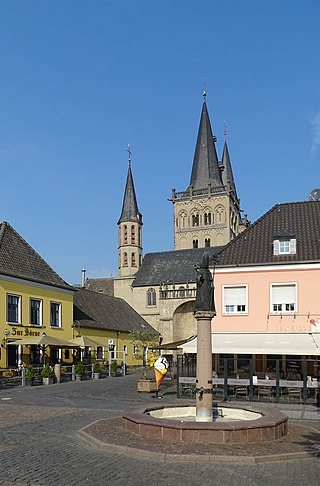
Xanten is a town in the state of North Rhine-Westphalia, Germany. It is located in the district of Wesel.
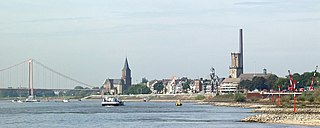
Emmerich am Rhein is a city and municipality in the northwest of the German federal state of North Rhine-Westphalia. The city has a harbour and a quay at the Rhine. In terms of local government organization, it is a medium-sized city belonging to the district of Kleve in the administrative region (Regierungsbezirk) of Düsseldorf.

The Duchy of Cleves was a State of the Holy Roman Empire which emerged from the medieval Hettergau. It was situated in the northern Rhineland on both sides of the Lower Rhine, around its capital Cleves and the towns of Wesel, Kalkar, Xanten, Emmerich, Rees and Duisburg bordering the lands of the Prince-Bishopric of Münster in the east and the Duchy of Brabant in the west. Its history is closely related to that of its southern neighbours: the Duchies of Jülich and Berg, as well as Guelders and the Westphalian county of Mark. The Duchy was archaically known as Cleveland in English.

Geldern is a city in the federal German state of North Rhine-Westphalia. It is part of the district of Kleve, which is part of the Düsseldorf administrative region. The Dutch province of Gelderland is named after this city.

Weeze is a municipality in the Lower Rhine (Niederrhein) region, located in the northwestern part of North Rhine-Westphalia, specifically in the district of Kleve and the Düsseldorf region.

Rees is a town in the district of Kleve in the state of North Rhine-Westphalia, Germany. It is located on the right bank of the Rhine, approximately 20 km east of Kleve. The population in 2005 was 22,559. Founded in 1228, Rees is the oldest town in the lower Rhine area.
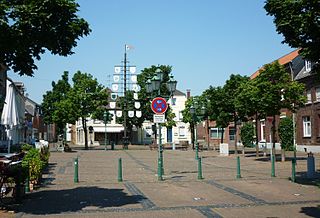
Grefrath is a municipality in the district of Viersen, in the western part of North Rhine-Westphalia, Germany.

The Duchy of Westphalia was a historic territory in the Holy Roman Empire, which existed from 1102 to 1803. It was located in the greater region of Westphalia, originally one of the three main regions in the German stem duchy of Saxony and today part of the state of North Rhine-Westphalia. The duchy was held by the archbishop-electors of Cologne until its secularization in 1803.

The United Duchies of Jülich-Cleves-Berg was a territory in the Holy Roman Empire between 1521 and 1666, formed from the personal union of the duchies of Jülich, Cleves and Berg.
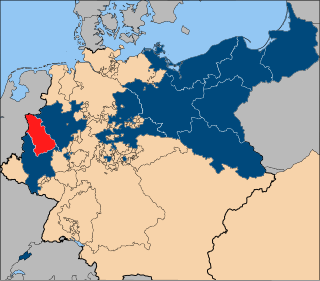
The Province of Jülich-Cleves-Berg was a province of Prussia from 1815 to 1822. Jülich-Cleves-Berg was established in 1815 from part restored and part newly annexed lands by the Kingdom of Prussia from France's Grand Duchy of Berg. Jülich-Cleves-Berg was dissolved in 1822 when it was merged with the Grand Duchy of the Lower Rhine to form Rhine Province. Cologne was the provincial capital.

The Grand Duchy of Berg, also known as the Grand Duchy of Berg and Cleves, was a territorial grand duchy established in 1806 by Napoleon after his victory at the Battle of Austerlitz (1805) on territories between the French Empire at the Rhine river and the German Kingdom of Westphalia.
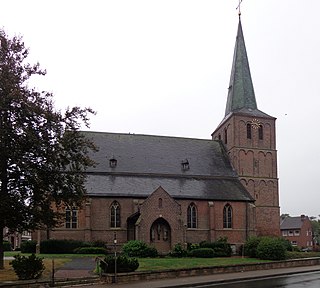
Kapellen an der Fleuth is a village of about 2600 people in northwest Germany near the border of the Netherlands. Since 1969 the village has been a part of the city of Geldern. Kapellen lies in the Niederrhein in the northwest part of German Federal State of Nordrhein-Westfalen. The village is approximately 72 kilometres from Düsseldorf, 16 km (10 mi) from the Rhine River at Xanten and 180 km (112 mi) from Amsterdam, Netherlands.
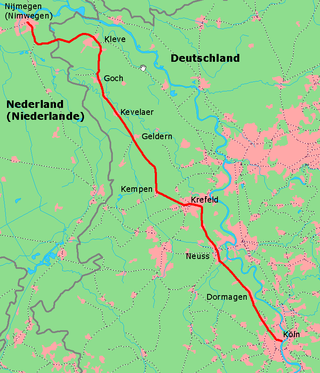
The Left Lower Rhine line is a main line on the left (western) bank of the Rhine in the lower Rhine region of the German state of North Rhine-Westphalia, running from Cologne to Cleves (Kleve) and formerly via Kranenburg to Nijmegen in the Netherlands. The Cologne–Krefeld section of the line was opened by the Cöln-Crefeld Railway Company in 1855 and is one of the oldest lines in Germany.

Upper Guelders or Spanish Guelders was one of the four quarters in the Imperial Duchy of Guelders. In the Dutch Revolt, it was the only quarter that did not secede from the Habsburg monarchy to become part of the Seven United Netherlands, but remained under Spanish rule during the Eighty Years' War.

Kleve is an electoral constituency represented in the Bundestag. It elects one member via first-past-the-post voting. Under the current constituency numbering system, it is designated as constituency 112. It is located in western North Rhine-Westphalia, comprising the district of Kleve.

































